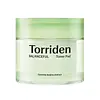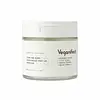What's inside
What's inside
 Key Ingredients
Key Ingredients

 Benefits
Benefits

 Concerns
Concerns

 Ingredients Side-by-side
Ingredients Side-by-side

Water
Skin ConditioningDipropylene Glycol
HumectantButylene Glycol
HumectantGluconolactone
Skin ConditioningPanthenol
Skin ConditioningAllantoin
Skin ConditioningSodium Hyaluronate
HumectantCentella Asiatica Extract
CleansingMadecassoside
AntioxidantAsiatic Acid
Skin ConditioningMadecassic Acid
Skin ConditioningAsiaticoside
AntioxidantCapryloyl Salicylic Acid
ExfoliatingHamamelis Virginiana Extract
AntiseborrhoeicAlthaea Rosea Flower Extract
Skin ConditioningNymphaea Caerulea Flower Extract
Skin ConditioningSwertia Japonica Extract
Skin ConditioningLactobacillus Ferment
Skin ConditioningGlycerin
HumectantHydroxyacetophenone
AntioxidantPantolactone
HumectantPolyglyceryl-10 Laurate
Skin ConditioningGlyceryl Acrylate/Acrylic Acid Copolymer
HumectantPvm/Ma Copolymer
Emulsion StabilisingHydrogenated Phosphatidylcholine
EmulsifyingSucrose Stearate
EmollientSodium Guaiazulene Sulfonate
Caprylic/Capric Triglyceride
MaskingCaprylyl Glycol
EmollientCholesterol
EmollientArginine
MaskingMelia Azadirachta Flower Extract
Skin ConditioningMelia Azadirachta Leaf Extract
Skin ConditioningDipotassium Glycyrrhizate
Humectant1,2-Hexanediol
Skin ConditioningDisodium EDTA
Ethylhexylglycerin
Skin ConditioningWater, Dipropylene Glycol, Butylene Glycol, Gluconolactone, Panthenol, Allantoin, Sodium Hyaluronate, Centella Asiatica Extract, Madecassoside, Asiatic Acid, Madecassic Acid, Asiaticoside, Capryloyl Salicylic Acid, Hamamelis Virginiana Extract, Althaea Rosea Flower Extract, Nymphaea Caerulea Flower Extract, Swertia Japonica Extract, Lactobacillus Ferment, Glycerin, Hydroxyacetophenone, Pantolactone, Polyglyceryl-10 Laurate, Glyceryl Acrylate/Acrylic Acid Copolymer, Pvm/Ma Copolymer, Hydrogenated Phosphatidylcholine, Sucrose Stearate, Sodium Guaiazulene Sulfonate, Caprylic/Capric Triglyceride, Caprylyl Glycol, Cholesterol, Arginine, Melia Azadirachta Flower Extract, Melia Azadirachta Leaf Extract, Dipotassium Glycyrrhizate, 1,2-Hexanediol, Disodium EDTA, Ethylhexylglycerin
Oryza Sativa Bran Water
MaskingButylene Glycol
HumectantDipropylene Glycol
HumectantGlycerin
HumectantDiglycerin
Humectant1,2-Hexanediol
Skin ConditioningWater
Skin ConditioningPolyglyceryl-10 Laurate
Skin ConditioningAcrylates/C10-30 Alkyl Acrylate Crosspolymer
Emulsion StabilisingTromethamine
BufferingCitric Acid
BufferingHydroxyethylcellulose
Emulsion StabilisingHordeum Vulgare Leaf Extract
Skin ConditioningBetaine
HumectantMelia Azadirachta Leaf Extract
Skin ConditioningBeta-Glucan
Skin ConditioningDextrin
AbsorbentHordeum Vulgare Extract
EmollientMelia Azadirachta Flower Extract
Skin ConditioningSuccinic Acid
BufferingPanthenol
Skin ConditioningCapryloyl Salicylic Acid
ExfoliatingMandelic Acid
AntimicrobialGardenia Florida Fruit Extract
Skin ConditioningPinus Densiflora Leaf Extract
AntimicrobialCoix Lacryma-Jobi Ma-Yuen Seed Extract
Skin ConditioningCitrus Junos Fruit Extract
Skin ConditioningArtemisia Princeps Leaf Extract
Skin ConditioningTocopherol
AntioxidantArtemisia Annua Extract
MaskingBenzoic Acid
MaskingBenzaldehyde
MaskingDisodium EDTA
Ethylhexylglycerin
Skin ConditioningOryza Sativa Bran Water, Butylene Glycol, Dipropylene Glycol, Glycerin, Diglycerin, 1,2-Hexanediol, Water, Polyglyceryl-10 Laurate, Acrylates/C10-30 Alkyl Acrylate Crosspolymer, Tromethamine, Citric Acid, Hydroxyethylcellulose, Hordeum Vulgare Leaf Extract, Betaine, Melia Azadirachta Leaf Extract, Beta-Glucan, Dextrin, Hordeum Vulgare Extract, Melia Azadirachta Flower Extract, Succinic Acid, Panthenol, Capryloyl Salicylic Acid, Mandelic Acid, Gardenia Florida Fruit Extract, Pinus Densiflora Leaf Extract, Coix Lacryma-Jobi Ma-Yuen Seed Extract, Citrus Junos Fruit Extract, Artemisia Princeps Leaf Extract, Tocopherol, Artemisia Annua Extract, Benzoic Acid, Benzaldehyde, Disodium EDTA, Ethylhexylglycerin
 Reviews
Reviews

Ingredients Explained
These ingredients are found in both products.
Ingredients higher up in an ingredient list are typically present in a larger amount.
1,2-Hexanediol is a synthetic liquid and another multi-functional powerhouse.
It is a:
- Humectant, drawing moisture into the skin
- Emollient, helping to soften skin
- Solvent, dispersing and stabilizing formulas
- Preservative booster, enhancing the antimicrobial activity of other preservatives
Butylene Glycol (or BG) is used within cosmetic products for a few different reasons:
Overall, Butylene Glycol is a safe and well-rounded ingredient that works well with other ingredients.
Though this ingredient works well with most skin types, some people with sensitive skin may experience a reaction such as allergic rashes, closed comedones, or itchiness.
Learn more about Butylene GlycolCapryloyl Salicylic Acid comes from salicylic acid, the famous acne-fighting BHA.
It usually goes by a more common name of LHA, or lipohydroxy acid.
Like salicylic acid, this ingredient is a chemical exfoliant that can help break down the oil in your pores and reduce inflammation.
Though studies for LHA do show it to be less effective than salicylic acid. To be fair, salicylic acid is the reigning monarch of acne treatments.
However, a study from 2009 found LHA to be comparable to BPO, making it a good alternative for people with sensitive skin. Another study of 14 patients found a significant decrease in comedones after using LHA.
Another pro of LHA? It is less irritating than salicylic acid due to its large molecule size.
Large molecules cannot penetrate skin as well, so they are gentler on the skin. LHA is much less penetrative than salicylic acid.
An in-vitro study (not done on a living organism) found only 6% of LHA penetrated past the statum corneum compared to 58% of salicylic acid. An in-vivo (done on a living organism) analysis revealed ~17% of LHA was still present in the top layer of skin after 4 days, versus ~9% of salicylic acid.
Interestingly, a study from 2008 found LHA comparable to another famous acid, glycolic acid.
This study found about 10% of LHA is as effective as 20-50% of glycolic acid in treating hyperpigmentation and fine-lines.
Hydroxy acids have been found to stimulate skin protein, lipids, and thermal thickening. This may have anti-aging benefits.
Learn more about Capryloyl Salicylic AcidDipropylene Glycol is a synthetically created humectant, stabilizer, and solvent.
This ingredient helps:
Dipropylene glycol is technically an alcohol, but it belongs to the glycol family (often considered part of the ‘good’ alcohols). This means it is hydrating and gentle on skin unlike drying solvent alcohols like denatured alcohol.
As a masking agent, Dipropylene Glycol can be used to cover the smell of other ingredients. However, it does not have a scent.
Studies show Dipropylene Glycol is considered safe to use in skincare.
Learn more about Dipropylene GlycolDisodium EDTA plays a role in making products more stable by aiding other preservatives.
It is a chelating agent, meaning it neutralizes metal ions that may be found in a product.
Disodium EDTA is a salt of edetic acid and is found to be safe in cosmetic ingredients.
Learn more about Disodium EDTAEthylhexylglycerin (we can't pronounce this either) is commonly used as a preservative and skin softener. It is derived from glyceryl.
You might see Ethylhexylglycerin often paired with other preservatives such as phenoxyethanol. Ethylhexylglycerin has been found to increase the effectiveness of these other preservatives.
Glycerin is already naturally found in your skin. It helps moisturize and protect your skin.
A study from 2016 found glycerin to be more effective as a humectant than AHAs and hyaluronic acid.
As a humectant, it helps the skin stay hydrated by pulling moisture to your skin. The low molecular weight of glycerin allows it to pull moisture into the deeper layers of your skin.
Hydrated skin improves your skin barrier; Your skin barrier helps protect against irritants and bacteria.
Glycerin has also been found to have antimicrobial and antiviral properties. Due to these properties, glycerin is often used in wound and burn treatments.
In cosmetics, glycerin is usually derived from plants such as soybean or palm. However, it can also be sourced from animals, such as tallow or animal fat.
This ingredient is organic, colorless, odorless, and non-toxic.
Glycerin is the name for this ingredient in American English. British English uses Glycerol/Glycerine.
Learn more about GlycerinMelia Azadirachta Flower Extract is from the Neem tree. Neem trees originate from India.
Melia Azadirachta Flower Extract contains antioxidants. Antioxidants help fight free-radicals. Free-radicals are molecules that may damage your skin cells, such as pollution.
The flowers of this tree are lilac colored.
Learn more about Melia Azadirachta Flower ExtractMelia Azadirachta Leaf Extract is extract from the neem plant.
The leaves of this tree contain flavonoids and polyphenols. These two compounds are antioxidants, anti-inflammatory, and antibacterial. Further research is needed as to their effects when applied on skin.
Panthenol is a common ingredient that helps hydrate and soothe the skin. It is found naturally in our skin and hair.
There are two forms of panthenol: D and L.
D-panthenol is also known as dexpanthenol. Most cosmetics use dexpanthenol or a mixture of D and L-panthenol.
Panthenol is famous due to its ability to go deeper into the skin's layers. Using this ingredient has numerous pros (and no cons):
Like hyaluronic acid, panthenol is a humectant. Humectants are able to bind and hold large amounts of water to keep skin hydrated.
This ingredient works well for wound healing. It works by increasing tissue in the wound and helps close open wounds.
Once oxidized, panthenol converts to pantothenic acid. Panthothenic acid is found in all living cells.
This ingredient is also referred to as pro-vitamin B5.
Learn more about PanthenolPolyglyceryl-10 Laurate is an ester of lauric acid and Polyglycerin-10.
Polyglyceryl-10 Laurate is a cleansing agent and emulsifier. It helps gather dirt, oil, and other pollutants to be rinsed away. As an emulsifier, it helps prevent ingredients from separating, such as oil and water.
Polyglyceryl-10 Laurate may not be fungal acne safe.
Learn more about Polyglyceryl-10 LaurateWater. It's the most common cosmetic ingredient of all. You'll usually see it at the top of ingredient lists, meaning that it makes up the largest part of the product.
So why is it so popular? Water most often acts as a solvent - this means that it helps dissolve other ingredients into the formulation.
You'll also recognize water as that liquid we all need to stay alive. If you see this, drink a glass of water. Stay hydrated!
Learn more about Water